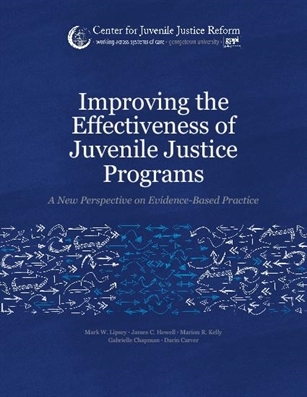Improving the Effectiveness of Juvenile Justice Programs: A New Perspective on Evidence-Based Practice
Published Dec 3, 2010, Mark W. Lipsey, James C. Howell, Marion R. Kelly, Gabrielle Chapman, Darin Carver
Download
(3264 KB)

Interventions for juvenile offenders should alter their behavior in ways that reduce their delinquency and improve their chances to prosper as productive citizens. Juvenile justice systems make use of many programs intended to accomplish these purposes, but the effectiveness of those programs is often difficult to determine and largely unknown. An increasing body of research evidence identifies effective programs and provides tools for matching those programs to the treatment needs and recidivism risks of the offenders served. That research is now sufficient to guide juvenile justice systems toward evidence-based practice models that offer the prospect of better outcomes and improved cost effectiveness. However, this research evidence and the tools it supports have not yet been well integrated into most juvenile justice systems. In part, this lag is due to the inherent difficulty of organizational change, but another factor is the piecemeal nature of the relevant research such that no coherent picture has emerged of how it can be integrated into juvenile justice practice in a way that is practical on an ongoing routine basis.
This paper introduces a framework for major juvenile justice system reform that integrates evidence-based programs and structured decision-making tools with a forward-looking, sustainable administrative model. Central to this framework are programs organized around services that address criminogenic risk factors and enhance adaptive functioning for the treated offenders. Such programs need not be restricted to the brand name model programs that appear on various lists of evidence-based practices. Meta-analysis of more than 500 controlled studies conducted by Dr. Mark Lipsey has identified the key characteristics associated with positive effects on recidivism for many of the types of programs already widely used in juvenile justice systems. A new tool based on those research findings defines concrete best practice guidelines that can be used routinely within a juvenile justice system to identify effective programs and improve those with the potential to be effective. Completing the repertoire for evidence-based practice are empirically validated needs and risk assessment instruments that provide an objective basis for appropriately allocating those programs to offenders.
To optimize positive outcomes for youth and the community in a cost effective manner, effective programs must be matched to offenders’ criminogenic needs and risks. The scaffolding for that process is the OJJDP Comprehensive Strategy. The key objectives of this administrative model are (a) developing and sustaining an appropriate array of effective evidence-based programs, and (b) implementing and sustaining structured decision making about juveniles’ program placements and supervision levels based upon objective assessments of risk and needs. Such a system is forward-looking by constructing case management plans focused on improving future behavior while holding juveniles accountable for the delinquent behavior that brought them into the juvenile justice system. And, such a system is performance-oriented by organizing around evidence-based practices aimed at optimizing positive system outcomes in a cost-effective manner. The framework for evidence-based practice described in this paper offers juvenile justice systems a practical way to use research about effective juvenile justice interventions to attain improved outcomes for the youth in their care and the communities they serve.